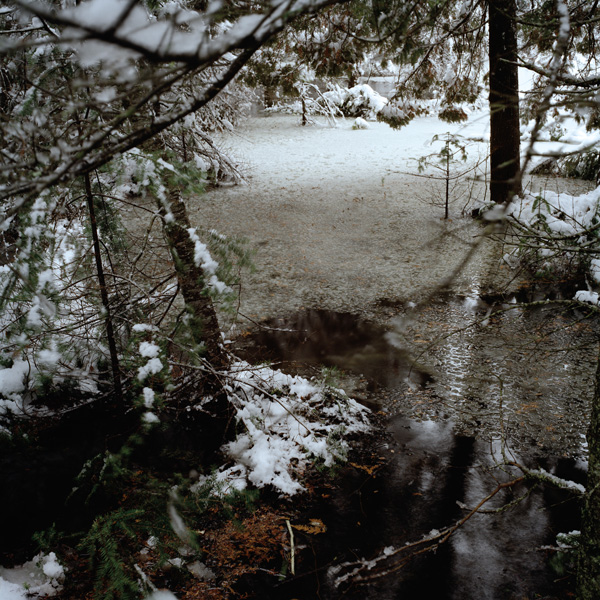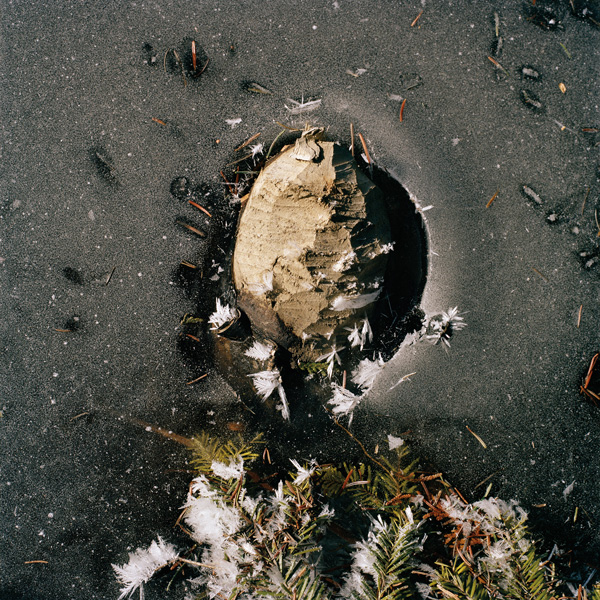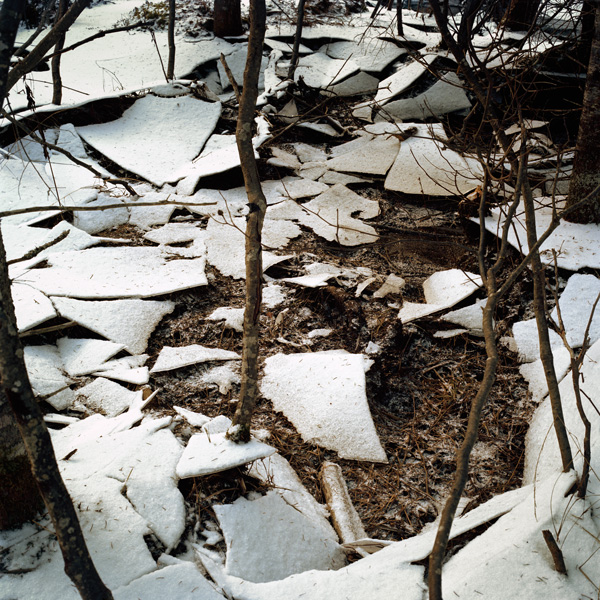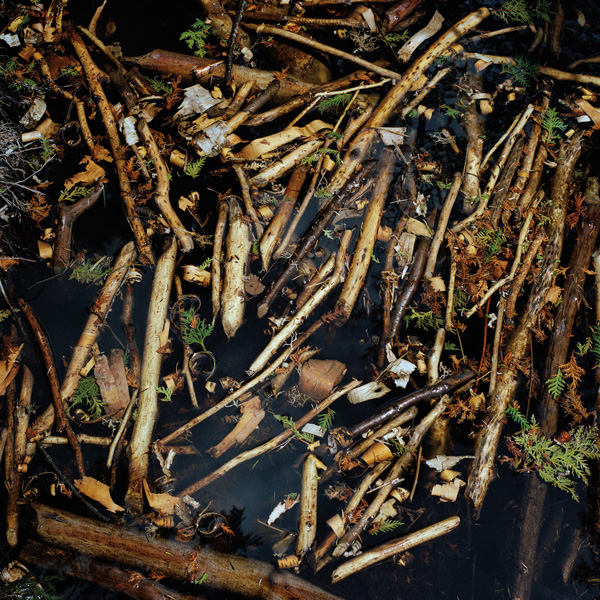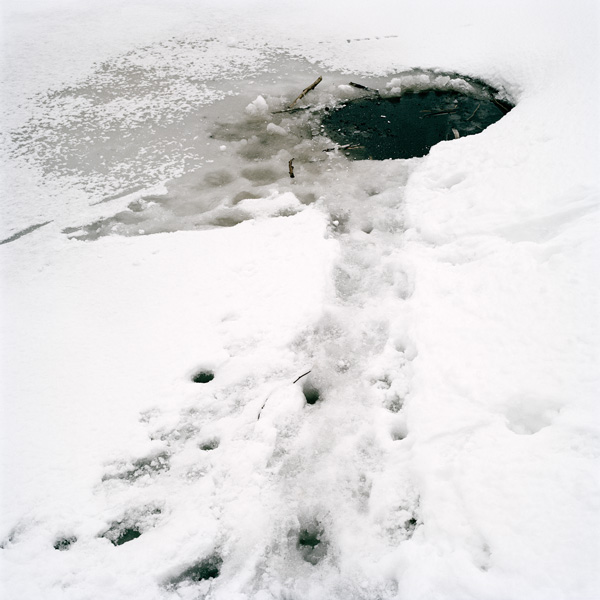Le chantier: the first image. Through marks and lines – green, taupe, orange – a wet woodlands glistens. In the foreground, three black tree trunks. The one in the centre is cut open at the base, showing freshly gnawed yellow flesh. It partially hides a pile of branches arranged in an outwardly spreading form – the key, the sun of the image. Then, other photographs. A forest with a stretch of snowy water; a composition carved out by a rivulet; bleached branches floating on a black background. The heavy, the angular, the spongy, the abundant, the shiny, the volatile: phenomena stemming from a central point. A beaver dam.
But let’s go back a bit. For thirty years, Normand Rajotte has been casting his attentive gaze at nature, and for almost twenty years he has been meandering through the bends and folds of this very forest. Abandoning the social approach that he had adopted in the 1970s – notably with Transcanadienne sortie 109, a photo essay on the daily life in a working class city – he acquired a plot of land in the Eastern Townships in 1997, and it became his preferred territory of investigation. His photographic series have evocative titles, giving a glimpse of the tonality and movements of a private, intuitive practice: Comme un murmure, Marcher sa trace, Entrer dans les terres, Des après-midi sans bruit, Dans les coins oubliés, à la recherche des dieux tranquilles. Exoticism, he says, does not interest him. Neither the deserts and canyons of Arizona nor the warm climes of Spain where he has worked – although present in Marcher sa trace – have given him the feeling that he is an essential part of the landscape. The work that he produces is intended to be as close as possible to the forest that he is constantly observing. Without trying to domesticate it, he tames it; he detects its nuances and transformations; he glimpses its depth and complexity. In doing this, he learns about the animals, insects, and plants on the territory he occupies and of which he has become a part. He even speaks of a sort of “history” of the place and its inhabitants. The feral lens of his camera is on the lookout for any signs around him, but also within him. Simply, without technical artifices, he turns away from distant horizons. The result is images that may show a bit of sky but are focused closely on mud, peat, undergrowth. His eye glued to the ground, he scrutinizes organic materials, mineral materials, water that stagnates or trickles away. He knows that everything – life, death – plays out exactly here.
Rajotte describes the path of his aesthetic progress as a spiral. He loops around to revisit the same sites, the same subjects, without ever completely becoming habituated to them, still and always drawn to deflected perspectives. And yet, after three decades of photographing the forest without a particular point of attachment, by chance as he walked, he found rising water, and a dam. His work became active, mysteriously drawn back in the branches. It was gradually catalyzed by the work of the beavers, which became the focus, rejuvenation, and transformation of his practice. His camera, up to then turned to the ground, tipped horizontally and pulled back, opening a greater depth of field. François Jullien wrote in a meditation on Chinese painting that “in contemplating a landscape from afar, we capture its lines of life [whereas] considering it from close up, we grasp its substance.” Two regimes of the gaze seem to cohabit here in the same site.
Rajotte spent three years documenting the beaver dam that he discovered some four hundred feet from his house. He captured the effects of the beavers’ presence on the land, from the most obvious to the subtlest signs. Although we are familiar with images of habitations, the living spaces of civilizations, the images that we have of these animals’ dwellings are enigmatic; they are difficult to find as they are almost swallowed up in the landscape. One might say that beavers are, after human beings, the first animals to modify their environment on a very large scale. In fact, they do more than inhabit the land; they incubate a complete ecosystem – generate and maintain a living environment. Nothing less. In the beavers’ presence, bodies of water are created; surrounding fauna and flora are complexified; forest humus is enriched with the debris that are gathered (dead leaves, needles, pollen, flowers). Furthermore, they can change the flow and level of water, even redirecting and redesigning streambeds. Literally, they help to model the morphology and composition of landscapes. Through their activity, a point in the forest comes alive and takes on a hundred moving faces.
For a photographer such as Rajotte, who likes to bring into his images moments of ambiguity and transition, the arrival of beavers on his land was not trivial. It meant more than a new subject to capture on film. These animals, as agents of transformation, brought him “actions” to contemplate: a collection of metamorphoses, births, sublimations, deaths, and rebirths. Behind the static, mute appearance of the images, a multitude of dynamic details is assembled. Delicately, a world is being structured: a tree bends in on itself, and a tiny layer of snow is deposited on its ripped bark; below, red needles slide on muddied water; nearby, moss and arched branches form a binding texture. The description could be expanded to inventory echoes and chords bearing witness to the improbable cohesion of the elements. No matter; Rajotte’s photographs are already full of this and more; they point to the precarious balance of phenomena connected, from near or far, to the site. Making himself a “spokesperson,” to use philosopher Étienne Souriau’s term, his photographs plead “in favour of their beauty.”
Although the presence of the beavers bears its share of collateral “beauties,” it does not come without collateral damage. Inevitably, the owners of neighbouring lots would like to have the dam dismantled. Yet, to preserve cohabitation, Rajotte intervenes, becomes invested. In addition to making breaches in the structure, he has installed an overflow pipe. He becomes close to the beavers’ work, even participates in it. He places one branch vertically, another horizontally, and another one diagonally; he plugs holes with roots and mud: the beavers’ technique is revealed to him. Obviously, the “precarious balance” mentioned above does not concern only the evanescence of visual phenomena. It also describes an area of photographic research closely overlapping an area of anonymous life. Both can be sensed at the surface of Le Chantier.
Rajotte insists on a zone of ambiguity, a mystery that he does not solve. When he enters the “secret” of the dam, like that of the image, he embraces the point of view of what he is photographing. This is where everything is tied together – existing and making exist – in a reciprocal construction. Sensing them as creation, Rajotte amplifies the visibility of phenomena that flow from the labour of the beavers, substances and lifelines. Could it be that he finds in these subjects halfsubmerged under the water a scansion of light and darkness that would return him to the roundabout of photography? As if, perhaps, to the eye of his own spiral.
Translated by Käthe Roth
2 François Jullien, La propension des choses. Pour une histoire de l’efficacité en Chine (Paris: Éditions du Seuil, 1992), 89 (our translation).
3 Étienne Souriau formulated a philosophy of art in which he posits the “testimonial” nature of creativity. “For Souriau, creating is, above all, testifying. Each creator of existence [or of an artwork] testifies in favour of what he creates in the manner of a pro domo plea.” David Lapoujade, “Étienne Souriau. Une philosophie des existences moindres,” in Philosophie des possessions, ed. Didier Debaise (Dijon: Presses du réel, 2011), 193 (our translation).
Caroline Loncol Daigneault is an author, curator, and researcher. Her interest in environmental issues inspired her master’s thesis in art studies (UQAM, 2011). In continuity with this work, in 2013–14, choreographer Tedi Tafel and the Vaste et Vague centre invited her to be a recording author for a project with local Mi’gmaq communities. In 2012, she was curator of the Biennale de sculpture de Saint-Jean-Port-Joli with the theme of hospitality, and then of ELLE MARCHE blue mountain, an exhibition with artist Vida Simon.

